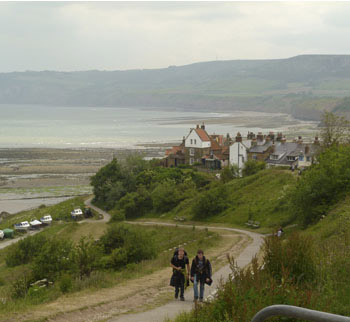How you imagine England to look from movies and novels – the archetypal England – is what you can expect to see in Yorkshire. Narrow winding roads soaring over steep hills, swooping down again through deep dales, moors sprinkled with sheep, flint walls that curve through grassy knolls for miles, and tiny villages brimming with character – it’s all Yorkshire.
Yorkshire is a historic county of Northern England, the largest county in the United Kingdom. Within its borders are areas that are widely considered to be among the greenest in England, due to the vast stretches of open countryside in the Yorkshire Dales and North York Moors, and to the open aspect of some of the major cities
Small village names are fascinating jumbles of never-seen-together letters, as they are a combination of Saxon and Viking names such as “Ugglesbarnby.” “By” at the end of the village indicates Viking heritage, and “Kirk” indicates a local church such as “Kirkbymoorside.”
Driving through the Yorkshire Moors and Dales is the best way to experience them, with essential stops along the way in the tiniest of villages and larger market towns such as Helmsley. South of the moors is the city of York with its Minster and Tudor architecture in the Shambles. The Shambles is an old street with overhanging timber-framed buildings, some dating back as far as the 14th century.
There are many places that are worth visiting in Yorkshire. Following are a few suggestions.
Fountains Abbey: This is a must-see for anyone going to Yorkshire. The M62 motorway, with the highest elevation in England, took us through the Pennine mountains en route to the abbey. Stunning views into valleys where picture-postcard villages sit invite you to detour and detour we did.
Fountains Abbey – an extraordinary apparition in North Yorkshire – is a masterpiece of 12th century building ingenuity. The dramatic remains of the abbey are the largest monastic ruins in the country. Following the dissolution of the monasteries in 1539 by Henry VIII, the abbey buildings and more than 500 acres of land were sold by the Crown. The land passed through several generations of the Gresham family and was finally to Stephen Proctor. He built Fountains Hall and turned the abbey grounds into a beautiful estate that includes a remarkable Georgian water garden.
Set in the naturally beautiful Skell valley, the abby is flanked by two vast expanses of grass lawns with awe-inspiring cliff faces to either side. The river Skell runs through the valley and under the abbey. This truly is a beautiful place to visit.
Helmsley: The small market town of Helmsley in Ryedale is about half an hour’s drive north from York, on the edge of the North York Moors National Park. It is a very pretty town and a magnet for visitors wanting a relaxing country break or to use it as a base for walking or other outdoor activities. You can spend a day wandering through the quaint streets, popping into shops and cafés, and exploring historic buildings. The town offers an eclectic mix of individual boutiques, antique shops and galleries, as well as tearooms, pubs, hotels, butchers and bakers. Helmsley is also a good base for setting off on more energetic pursuits.
White Chalk Horse: A most unusual landmark you can’t fail to miss in this part of Yorkshire is a chalk outline of a horse, cut into the side of the hill, just beside the village of Kilburn. The famous White Horse is massive, measuring more than 300 feet long by nearly 300 feet high, and can be seen from miles away. It was the work of John Hodgson, a local schoolmaster who with the help of his pupils completed it in 1857.
Whitby: It’s known as a working man’s seaside resort town. Even though Whitby is extremely touristy, with many souvenir shops, it’s worth a visit. I recommend a morning visit, as its normally a bit quieter. Ignore the tourist buses and walk to view the harbour and cliff views, then head inland a bit to see village life. For three pounds, take a 30-minute tour on an antique lifeboat, which cruises through the bay. From the boat you see a lovely view of Whitby.
Robin Hood’s Bay: A 10-minute drive along the coast takes you to this delightfully unique, hilly seaside village. Considered by many to be the prettiest fishing village on the Yorkshire coast, Robin Hood’s Bay clings precariously to steep cliffs, its tiny cottages with their distinctive red tile roofs crowding around the ravine of King’s Beck for protection against the fierce winds that blow in from the North Sea. A steep walk down to the sea takes you along a street lined with charming tearooms, cafés and art-gallery shops displaying tasteful, locally made art, and jewelry shops.
Boggle Hole: A bit farther along the coast from Robin Hood’s Bay, park your car and walk down to a craggy beach, a youth hostel and Boggle Hole, made famous in A.S. Byatt’s book, Possession. A “boggle” is the local name for a hobgoblin, the mischievous “little people” that were thought to live in caves along the coast, as well as the more remote corners of the moors. Boggle Hole was where smugglers used to land with their contraband. A cliff-top path offers superb views of Robin Hood’s Bay, which sweeps in a graceful curve. At low tide, bands of soft shale and hard limestone are revealed to enormous effect in the shape of curving ridges. The haunt of geologists and fossil hunters, this rocky shore is a fascinating place to explore, but keep a careful eye on the rising tide.
